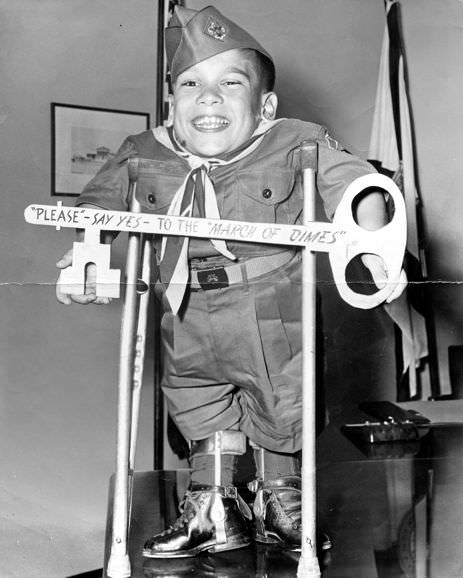
When checking out of the grocery store recently, I was asked if I’d like to add another $5 to my bill for the March of Dimes. I politely declined. I could afford it, but the organization offends my pro-life views. Even my recollection of an archival picture of a very cute March of Dimes poster boy—my husband Robert at age 11—did not change my mind.
Indeed I almost skipped reading the “This Day In History” entry for January 3, 1938 when Franklin Delano Roosevelt (FDR) founded the March of Dimes. I’m so glad I went beyond the headline.
Want to subscribe to receive blog updates sign up today!
I learned that FDR’s charitable concern came from his contracting poliomyelitis that paralyzed his legs 11 years before he became President. The March of Dimes began as an association of health scientists and volunteers funding physical rehabilitation and research for a polio vaccine. Paralysis disabled one out of 200 people infected and death was the end result for two to 10 of those who were paralyzed. Given the rapid pace of polio’s spread among children, the foundation could not raise money fast enough to keep pace with the contagion tagged as “the most feared disease of the 20th century.”
When the donations from wealthy benefactors did not meet the need, FDR appealed to the general public for funds. Despite a celebrity’s suggestion to send dimes to the President being said in jest, the public flooded the White House with 2,680,000 dimes and thousands of dollars in donations.
FDR died before Dr. Jonas Salk produced the first successful polio vaccine in 1955, but this March of Dimes funded research is an amazing accomplishment for FDR, Salk, and the organization. If I had only viewed the March of Dimes through the prism of their current pro-choice practices, I would have missed this historical nugget when the world is focused on COVID-19 vaccines. I would also have missed the changed perspective on how to publicly portray disability.
The presidential memorial commission won the debate on how to recognize FDR’s dependence on leg braces and a wheelchair for mobility. The 1997 Memorial opened with three FDR statues none of which revealed his disability. It deferred to FDR’s directive, and media acquiescence, to never photograph him in a wheelchair, walking, or being transferred from his car. As the President who led America out of the Depression and through World War II, he believed it was important to show strength.
This hiding of FDR’s disability was corrected on January 11, 2001 when a fourth statue was added. A life-sized statue shows FDR in his wheelchair at the Memorial entrance. It’s an accurate view of the man whose strength was in his leadership not his legs. One visitor teared when he saw a busload of children in wheelchairs entering the exhibit. They would see that disability doesn’t limit what people can accomplish and should not be hidden.
What would you miss if you viewed history through the prism of current events?
For more of my writings, go to https://angelamuirvanetten.com where you can subscribe to my weekly blog and find several retail links to my book, “Pass Me Your Shoes: A Couple with Dwarfism Navigates Life’s Detours with Love and Faith.”
TRIVIA
Polio plagued America for 39 years from 1916 to 1955.
At age 39. FDR contracted the virus.
Salk tested the first successful polio vaccine at age 39.

5 replies on “Viewing History Through Prism of Current Events”
I didn’t know the March of Dimes is pro-choice. Thanks for the history lesson. Happy new year and may 2021 be filled with blessings. Stay safe and well.
Here’s a link to one of many articles I read on March of Dimes support for terminating pregnancies when a pre-birth disability is diagnosed, “The Pro-Abortion Policies of the March of Dimes.” Christian Life Resources. Accessed December 28, 2020. https://christianliferesources.com/2018/05/07/the-pro-abortion-policies-of-the-march-of-dimes/
I also did not know that the March of Dimes is a pro-choice organization. Roosevelt’s attempts to hide his disability, though based on a practical decision at the time surely robbed millions of disabled people of a positive role model. Good thing “Mr Enthusiasm” didn’t need it—in many ways, he’s the same person today that he was at 11. While his disability is the first thing people see, that’s not what people remember about him. Happy New Year to both of you!
Great research. I’m glad to be more informed on the history and current position of the March of Dimes. Interesting highlight of the change in perspective on disability surrounding the life of FDR. It is positively amazing what people can accomplish when they embrace who they were created to be & reach for the heights to which they are called.
It is also important to embrace disability life changes that come our way with age, illness, accidents, crime, and/or war.